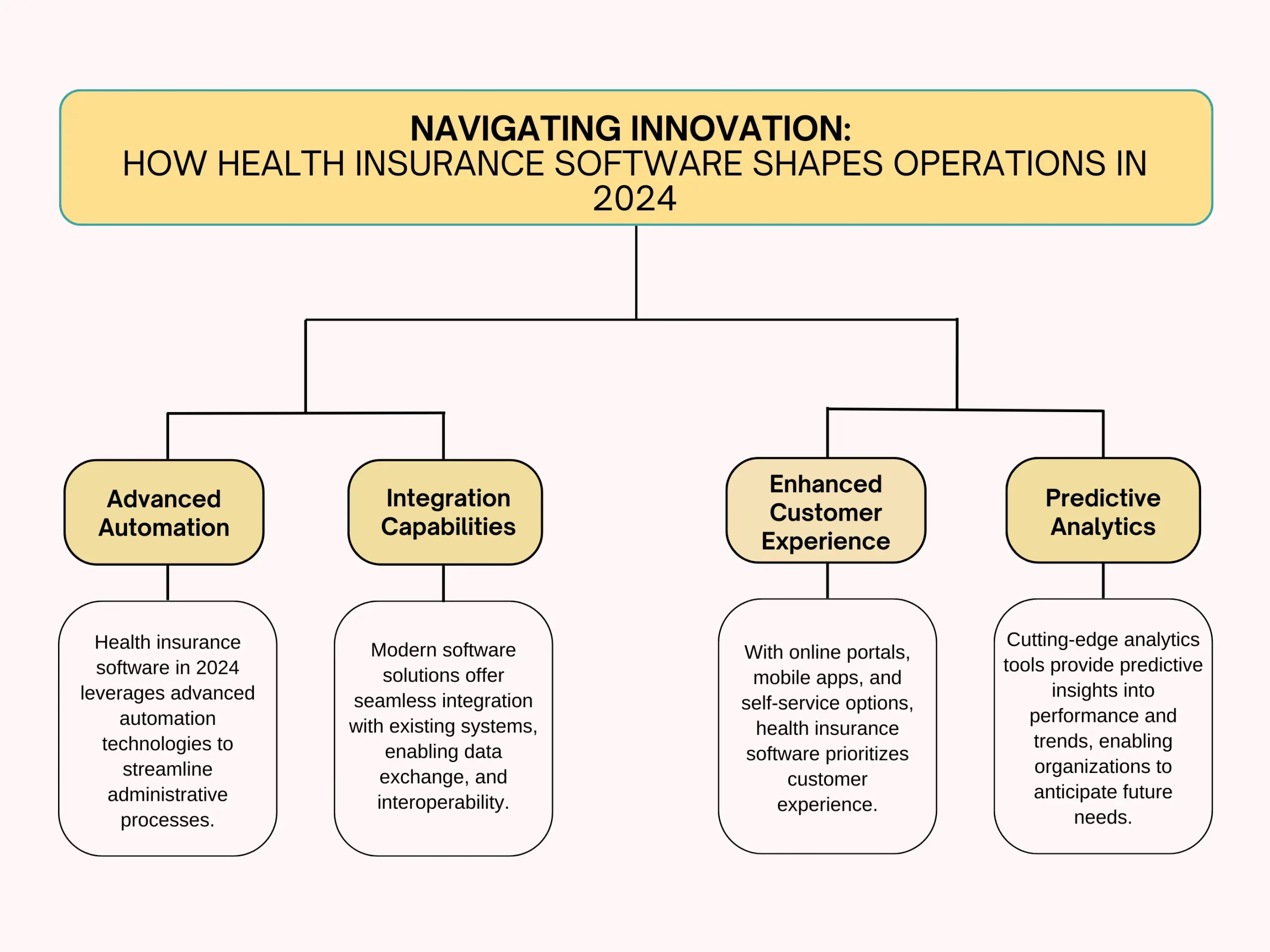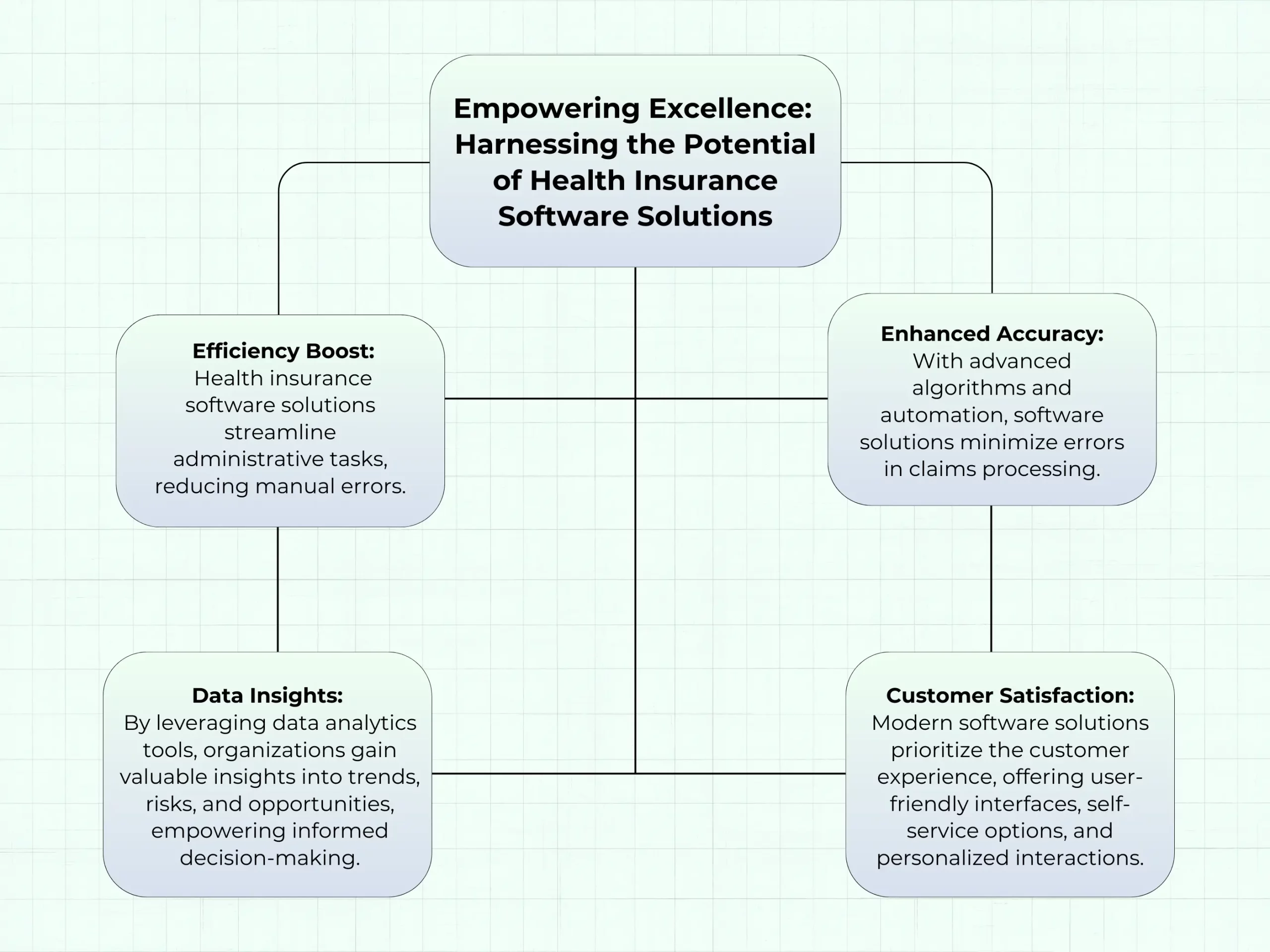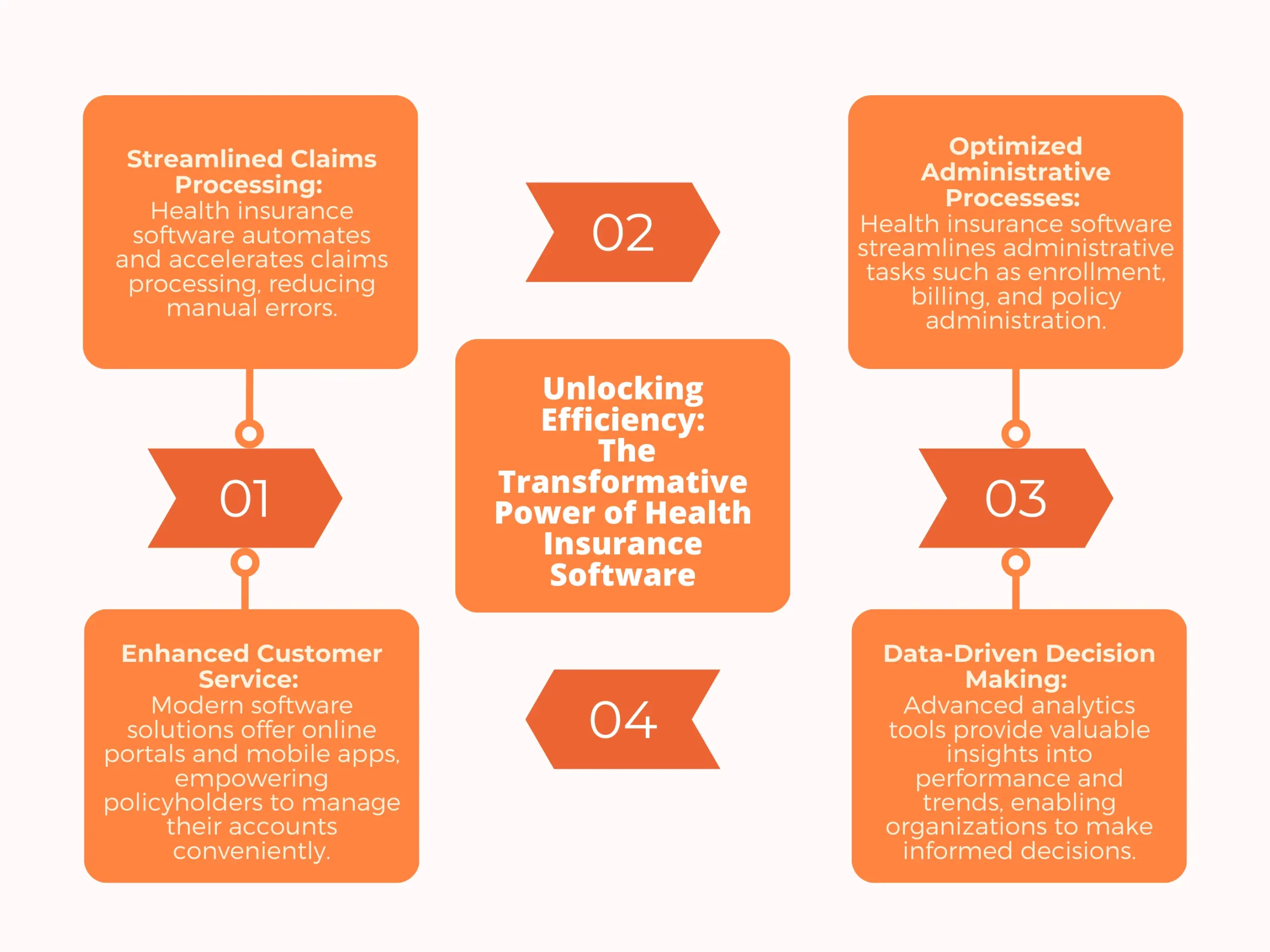Technology’s role is now crucial. Health insurance software has emerged as a key tool for insurers in 2025. The demand for efficient operations is soaring. So, the right health insurance software is now key for big medical insurance companies. They need to stay ahead and serve their clients well. Healthcare is changing a lot. It’s driven by many factors. They include the rise of electronic health records (EHRs) and telehealth services. Therefore, they also include the growing use of data to make decisions. Recent research by Grand View Research found the global health insurance software market will reach $7.8 billion by 2027. It will grow by 5.5% each year from 2020 to 2027. This fast growth shows the crucial role of health insurance software. It helps modernize and boost efficiency in healthcare.
Health insurance providers in 2025 will face a main challenge. It is the complex nature of insurance operations. These operations often involve managing lots of data. They also involve navigating complex rules. You must ensure smooth communication with policyholders and healthcare providers. Old manual methods and paper systems are no longer sustainable in this fast-paced digital era. The health insurance industry now needs tailored, advanced software.
In the next sections, we will dive into how the right health software can change many parts of operations. It will affect claims processing, policy administration, customer engagement, and regulatory compliance. We will use real-world examples, case studies, and expert insights. Finally, they will show the clear benefits and best practices of using health insurance industry trends that empower organizations to thrive in digital healthcare.
Table of Contents
Looking for Healthcare Tech Upgrade? Let’s Build Your Next Software Solution Together!
Understanding The Importance of Health Insurance Software
In healthcare, technology is key. It helps operations be efficient and effective. Health insurance software has become a critical tool for insurance providers. It offers many benefits that range from faster claim processing to better customer service. Understanding the importance of health insurance software is key. They must meet their client’s changing needs by 2025.
1. Rising Demand for Efficiency
Firstly, Healthcare systems are getting more complex and need to handle more data. This trend is boosting the need for efficient health insurance. Research and Markets predicts in a report that the global healthcare IT market will hit $390.7 billion by 2027. This market includes health software. It’s expected to grow by 11.7% from 2020 to 2027.
2. Streamlining Claims Processing
Secondly, Health insurance software makes claims processing easier, reduces errors, and speeds up reimbursements. Accenture’s research shows that digital claim solutions can cut costs by 30% and increase accuracy by 90%.
3. Enhancing Customer Service
Thirdly, people want smooth digital experiences. Health software helps meet this need. A PwC survey found that 73% of consumers see easy access to healthcare as vital. The software offers online portals, mobile apps, and self-service options. These tools let the best custom software development companies manage their accounts and access information.
4. Optimizing Administrative Processes
Health insurance software does more than handle claims. It also improves tasks like enrollment, billing, and policy management. A McKinsey study showed that digitizing these processes can cut costs by up to 15%. It also streamlines workflows and reduces manual work, making operations more efficient.
5. Facilitating Regulatory Compliance
Insurance providers focus on meeting regulations. They use health software to ensure compliance. This software offers automated reporting and audit trails. As a result, it helps them follow laws like HIPAA and the ACA. This reduces the chance of fines.
6. Enabling Data-Driven Decision Making
Lastly, Health insurance software offers crucial data insights. These help custom software development services make smart decisions and boost strategic efforts. A report found that 53% of healthcare groups rank data analytics for performance. Insurers use analytics to spot trends, manage risks, and improve efficiency. This leads to better performance and profits.
Moreover, the software aids insurers in the complex healthcare world. Finally, it boosts efficiency and enhances customer service. With this technology, organizations can prepare for success. The market is digital and competitive.
Exploring the Benefits of Implementing Health Insurance Software
Using health insurance software is crucial for providers. It streamlines operations, boosts efficiency, and enhances service. However, tailored software brings many benefits. It optimizes processes and improves the customer experience. Now, let’s explore the benefits of using health insurance software in 2025.
1. Streamlined Claims Processing
Firstly, Health insurance software streamlines claim processing, reducing manual errors, and accelerating reimbursement cycles. Accenture’s research found that using digital tools for claims management can cut claims costs by up to 30%. Many custom software development consulting companies boost accuracy by as much as 90%, reducing manual errors and enhancing overall operational efficiency, ultimately improving customer satisfaction and retention.
2. Enhanced Customer Experience
Secondly, Modern consumers expect smooth digital experiences. Health insurance software lets providers meet these expectations. PwC’s survey found that 73% of consumers think easy healthcare access is essential. Health software offers online portals, mobile apps, and self-service options. They help policyholders manage their accounts and access information.
3. Improved Operational Efficiency
Thirdly, Health insurance software optimizes many administrative processes. It covers enrollment, billing, and policy administration. This improves operational efficiency. A study by McKinsey found that digitizing administrative processes can cut costs by up to 15%. Subsequently, it can improve efficiency by streamlining workflows and cutting manual work.
4. Facilitated Regulatory Compliance
Complying with rules is a top priority for insurers. It helps to ensure adherence to complex regulations. The software has features like automated reporting and audit trails. They let organizations show compliance with laws like HIPAA and the ACA. This reduces the risk of fines and penalties.
5. Data-Driven Decision Making
Health insurance software provides access to valuable data insights. They empower organizations to make informed decisions and drive strategic initiatives. A report says 53% of healthcare organizations cite data analytics as a top priority. They want to use it to improve performance. Insurers can use analytics tools. They can use them to find trends, assess risks, and improve processes. This boosts their performance and profits.
6. Cost Savings
Lastly, implementing health insurance software can lead to significant cost savings for insurance providers. By cutting manual work and errors and improving workflows, custom software development services can gain efficiency. This leads to real cost savings over time. Also, spotting and reducing risks with data analytics can cut losses and boost profits.
Implementing health software has many benefits. These include better efficiency and customer experience. They also bring easier compliance and cost savings. By using these technologies, insurance providers can stay competitive. Finally, they can also adapt to changing market trends and bring value to their clients and stakeholders.
Key Features to Look for in Health Insurance Software Solutions
Choosing the right health insurance software is crucial for insurers aiming to modernize and enhance efficiency to better serve their clients. With numerous options available on the market, it’s imperative to understand the key features to look for. Benefits open enrollment plays a pivotal role in ensuring that the selected software aligns with the organization’s needs and objectives. Therefore, insurance providers should thoroughly consider these features when evaluating health insurance software in 2025.
1. Integration Capabilities
Firstly, Look for health insurance software solutions that can integrate with existing systems. These include electronic health records (EHRs), billing platforms, and third-party applications. Integrated systems enable data exchange. Therefore, they also streamline workflows and reduce the need for manual data entry. This leads to better operational efficiency and accuracy. According to a survey by HIMSS Analytics, 83% of healthcare organizations say that integration is a top consideration. They say this when selecting health IT solutions.
2. Claims Processing Automation
Secondly, Health insurance industry trends emphasize the importance of automating claim processing. This allows insurance providers to accelerate claim adjudication, reduce errors, and enhance efficiency. McKinsey found that automating claim processing can save up to 30%. Look for software solutions with advanced algorithms and machine learning. They should also have real-time analytics. These features streamline claim workflows and optimize reimbursement.
3. Comprehensive Reporting and Analytics
Thirdly, Using data to make decisions is key for insurers. They use it to improve performance, find trends, and reduce risks. Choose health insurance software solutions. They have strong reporting and analytics. Therefore, they let organizations get useful insights from vast amounts of data. A study by Deloitte found that 45% of healthcare organizations think analytics are critical. They see them as key to boosting operations and driving strategy.
4. Security and Compliance Features
Security and compliance are top priorities in healthcare. Patient data must be protected, and rules must be followed. Look for health software solutions. They should have strong security features, like encryption, access controls, and audit trails. These features protect the data’s integrity and confidentiality. Also, ensure the software follows relevant regulations, such as HIPAA and ACA. This will reduce the risk of fines for non-compliance.
5. User-Friendly Interface
The interface must be user-friendly. This is vital for getting users to adopt it and for maximizing staff productivity. Choose health insurance software solutions. They offer easy navigation, customizable dashboards, and user-friendly features. These improve usability and accessibility. A survey by Black Book Market Research found that 92% of big medical insurance companies believe user experience is critical. They think it’s critical in selecting health IT solutions.
6. Scalability and Flexibility
Lastly, the healthcare landscape is changing. Insurance providers need software that can scale and adapt. Look for solutions that scale and flex. They allow organizations to expand operations, add features, and grow without much disruption. Scalable software solutions let insurance providers future-proof their operations. Finally, they also help them stay competitive in a fast-changing market.
Take Your Health Insurance Business To The Next Level. Request a Free Consultation Today!
Steps to Implementing Health Insurance Software Successfully
Implementing health insurance software is strategic. It’s key for insurance providers who want to modernize. It will help them improve efficiency and make customers happier. But implementing it can be hard. It requires careful planning, getting stakeholders involved, and effective execution. In this guide, we will outline the key steps to installing health insurance software in your organization. We will also provide data and insights to support each stage of the process.
1. Assessment of Organizational Needs
Firstly, Before starting to put it in place, assess your organization’s needs, goals, and challenges. However, to identify inefficiencies in current processes, uncover gaps in existing technology, and pinpoint opportunities for improvement to optimize operations and enhance overall performance. A study by HealthIT.gov found that 73% of healthcare organizations cite improving efficiency as a top reason. They use health IT solutions for this.
2. Vendor Selection and Evaluation
Secondly, Research and check with potential health insurance software vendors. However, base this on factors such as what the software can do, how well it can grow, how reliable it is, and its cost. Ask for proposals. See demos. Discuss with vendors. Do this to judge their suitability for your organization’s needs. According to a KLAS Research survey, when selecting health IT solutions, 87% of the best custom software development companies prioritize vendor reputation and customer references as critical factors.
3. Customization and Configuration
Thirdly, Work with the chosen vendor. Customize the health software to fit your needs and workflows. You will define requirements and set implementation timelines. You will work with internal stakeholders to ensure the plan fits business goals. A report by McKinsey says 70% of digital transformation initiatives fail. They fail because technology and business goals aren’t aligned.
4. Training and Change Management
Train and support employees well. This will ensure a smooth switch to the new health insurance software. This is to address any concerns or challenges. Use change management strategies. They promote adoption and cut resistance among staff. Prosci’s research found that effective change management makes meeting project goals six times more likely.
5. Data Migration and Integration
The task is to plan and do data migration from old systems to the new health insurance software. The goal is to keep the data accurate and secure. However, establish integration points with existing systems, such as electronic health records (EHRs) and billing platforms, to enable seamless data exchange and interoperability. In a study by Black Book Market Research, 90% of software for health insurance companies identified data migration as a significant challenge in implementing health IT solutions.
6. Testing and Quality Assurance
Conduct thorough testing and quality assurance procedures to identify and address any issues or discrepancies before deploying the health insurance software in a live environment. Therefore, test the software to ensure it meets quality standards. Test its functions, usability, and performance. This will ensure it delivers optimal performance. Capgemini’s research shows that bad testing causes most IT project failures. 61% of organizations have big issues due to insufficient testing.
7. Deployment and Go-Live
Execute the deployment plan and go-live strategy for the health insurance software. Ensure they cause minimal disruption to operations and keep services running. Check the system’s performance. Address any issues after deployment. Provide ongoing support to users as needed. A study by HIMSS Analytics found that 82% of organizations experience disruptions. The disruptions happen during system deployments. This shows the importance of good planning and execution.
8. Monitoring and Optimization
Check the health insurance software’s performance. Gather feedback from users. Identify areas to optimize and improve. Install updates, patches, and enhancements often. This keeps the software current and aligned with evolving business needs. Gartner’s research says that 65% of organizations will adopt continuous optimization. They will do so to drive digital transformation success.
9. Evaluation and Review
To ensure optimal performance and informed decision-making for future projects, conduct periodic evaluations and reviews of the health insurance quoting software. This process allows for assessing effectiveness, identifying lessons learned, and making smart choices moving forward. Ask for feedback from users, measure key performance indicators (KPIs), and benchmark against industry standards to gauge success and ROI. A study found that 77% of healthcare organizations conduct post-implementation reviews. They do this to test the success of health IT initiatives.
10. Continuous Improvement
Lastly, foster a culture of continuous improvement and innovation within your organization, leveraging insights from the implementation to drive ongoing enhancements and optimizations. Encourage collaboration. Encourage experimentation and knowledge sharing among stakeholders. This will help them find new ways to use technology to meet strategic goals. According to research by IDC, organizations that prioritize digital innovation are three times more likely to achieve significant revenue growth than their peers.
Finally, by following these steps and leveraging data-driven insights, insurance providers can successfully implement health insurance software. Therefore, to realize the benefits of modernization, efficiency, and improved customer satisfaction in their operations.
How Do You Choose the Right Health Insurance Software for Your Organization?
Selecting the right health software for your organization is a critical decision that can significantly impact operational efficiency, customer satisfaction, and overall business success. With a wide range of options available on the market, each offering varying features, functionalities, and pricing structures, navigating the selection process can be daunting. In this guide, we will outline key considerations and steps to help you choose the right health insurance software solution that aligns with your organization’s needs, objectives, and budget.
1. Assess Organizational Needs
Start by conducting a comprehensive assessment of your organization’s needs, objectives, and challenges. Identify existing process pain points, technology infrastructure gaps, and areas for enhancement. Engage product engineering services companies in USA from various departments to gather insights and perspectives on desired features and functionalities.
2. Define Key Requirements
Secondly, Based on the assessment, define a list of key requirements and functionalities that the health insurance software must have to meet your organization’s needs. However, prioritize requirements based on importance and feasibility, considering factors such as claims processing, customer service, regulatory compliance, and scalability.
3. Research and Compare Solutions
Thirdly, Research and evaluate multiple health insurance software solutions available on the market. Consider factors such as vendor reputation, product features, scalability, pricing, and customer support. Moreover, request demos, explore online reviews and testimonials, and engage with vendor representatives to gain a comprehensive understanding of each solution.
4. Consider Integration Capabilities
Assess how well each piece of health insurance software integrates with your systems. These include electronic health records (EHRs), billing platforms, and third-party applications. Importantly, make sure the systems are compatible. They should exchange data. This will cut disruption and boost efficiency.
5. Test Customization Options
Test the customization options available in each health insurance software. Evaluate whether the software can be tailored to align with your organization’s specific needs and workflows. Additionally, examine whether Benefits Open Enrollment 2025 provides configurable modules, templates, and workflows for customization.
6. Assess Security and Compliance
Security and compliance are vital in healthcare. Patient data must be protected, and rules must be met. Test the security and compliance features of each health software. It also covers access controls, audit trails, and compliance with regulations such as HIPAA and ACA.
7. Consider User Experience
An easy-to-use interface is vital. It ensures that users adopt it and that staff are productive. Test the user experience of each health software. Consider factors such as ease of navigation, intuitiveness, and accessibility. Choose a solution with a seamless and easy-to-use user experience. This will promote user adoption and cut training needs.
8. Assess Vendor Support and Training
Consider the level of support and training offered by each health insurance software vendor. Assess the availability of customer support, training resources, documentation, and ongoing support options. Choose a vendor. They should provide full support and training. This will ensure a smooth setup and the best use of the software.
9. Review the Total Cost of Ownership
Test the total cost of ownership (TCO) associated with each health insurance software solution. Evaluate not only the upfront costs but also ongoing expenses such as maintenance, support, and upgrades. Take into account factors like licensing fees, implementation costs, customization fees, and long-term subscription or maintenance fees.
10. Seek Feedback and Recommendations
Lastly, Ask peers, industry experts, and other organizations for feedback and recommendations. They have implemented health insurance software. Learn from their experiences, insights, and challenges. Use this to guide your decisions and ensure a successful implementation.
Follow these key ideas and steps. With them, you can choose the right health insurance software. It will meet your organization’s needs, objectives, and budget. Finally, it will let you improve operations, make customers happier, and meet your goals.

How Do You Compare Different Health Insurance Software Providers?
Selecting the appropriate health insurance software provider is a crucial decision for insurance organizations aiming to modernize operations, streamline processes, and provide excellent service to clients. With numerous options available on the market, each offering unique features, functions, and prices, comparing health insurance enrollment software providers requires careful consideration and evaluation. In this guide, we will outline key factors and steps to assist you in comparing and selecting the best health insurance enrollment software provider tailored to your organization’s needs and goals.
1. Identify Your Organization’s Needs
Firstly, Start by identifying your organization’s needs, goals, and health insurance software challenges. Consider factors like processing claims, serving customers, obeying rules, scaling, and budget limits. Talk to stakeholders in all departments. Do this to get their insights and views on desired features and functions.
2. Research Many Providers
Secondly, Research and make a list of the many health insurance software providers. They are available on the market. Explore online resources, industry publications, and peer recommendations to identify potential providers. Consider factors such as vendor reputation, product features, scalability, pricing, and customer support.
3. Assess Product Features and Functionalities
Thirdly, Test the features and functionalities offered by each healthcare software provider. Consider factors such as the ability to process claims. Tools for customer service and features for reporting and analytics. Also, there is the ability to integrate and options for customization. Assess whether the software aligns with your organization’s specific needs and workflows.
4. Consider Integration Capabilities
Assess how well each health insurance software provider integrates with your existing systems. Therefore, these include electronic health records (EHRs), billing platforms, and third-party applications. Make sure the systems are compatible. Also, ensure they exchange data. This will reduce disruption and maximize efficiency.
5. Check Customization Options
Determine the level of customization available with each health insurance quoting software provider. Evaluate whether the provider offers configurable modules, templates, and workflows that can be tailored to suit your organization’s specific needs and workflows.
6. Review Security and Compliance Features
Security and compliance are vital in healthcare. Patient data must be protected, and rules must be followed. Test the security and compliance features of each healthcare software provider. This includes data encryption. It also has access controls, audit trails, and compliance with regulations. These include HIPAA and the ACA.
7. Assess Customer Support and Training
Consider how much customer support and training each health insurance software provider offers. Therefore, test the availability of customer support, training resources, documentation, and ongoing support options. Choose a provider that has great support and training. They will ensure a smooth implementation and the best use of the software.
8. Review Customer Feedback and Testimonials
Seek feedback and testimonials from current customers of each health insurance software provider. Look at online reviews, case studies, and testimonials. They will give insights into the provider’s reputation, customer satisfaction, and success. Consider asking the references provided by the provider-specific questions. Learn about their experiences firsthand.
9. Compare Pricing and Value Propositions
Compare the pricing structures and value propositions of each health insurance software provider, taking into account upfront costs such as subscription or licensing fees. Additionally, consider implementation costs, customization fees, and ongoing support expenses to assess the total cost of ownership (TCO) and return on investment (ROI). Utilize these metrics to determine the best value for your custom enterprise software development company.
10. Schedule Demos and Ask questions
Lastly, Schedule demos with each health insurance software provider. You will see the software in action. You will ask about its features, functions, and abilities. Use this chance to clarify doubts. Address concerns. Understand how the software can meet an organization’s needs and goals.
Follow these key factors and steps. Then, you can compare health insurance software providers well. Then, you can select the best provider. Finally, it will meet your organization’s needs, objectives, and budget.
Transform Your Software Vision into Reality – Book A 30 Minutes Free Consultation!
Next Steps: Requesting a Demo or Consultation for Health Insurance Software Integration
Ready to take the next step towards integrating health insurance software into your organization? Requesting a demo or consultation is crucial for making decisions. They let you explore the software’s capabilities, ask questions, and assess its fit for your needs.
Here’s how to proceed:
1. Contact the Provider
Firstly, Reach out to the health insurance software provider to express your interest in scheduling a demo or consultation. Most providers offer contact forms on their websites. Or, you can reach them via phone or email.
2. Schedule a Demo
Next, coordinate with the provider to schedule a live demo of the health insurance enrollment software. During the demo, a representative will walk you through the software’s features and functionalities, demonstrating how it can effectively address your organization’s specific needs and challenges.
3. Prepare Questions
Thirdly, Before the demo, take some time to prepare a list of questions and topics you’d like to discuss. Consider asking about specific features. Ask about customization options and integration capabilities. Also ask about pricing, the implementation process, and customer support.
4. Attend the Demo
Attend the scheduled demo at the designated time, actively taking notes and engaging with the presenter by asking questions. This approach will allow you to gain a comprehensive understanding of the software’s capabilities and benefits, particularly about employee benefits open enrollment.
5. Request a Consultation
If you need more information or have specific needs, request a consultation with the provider. Consultations offer a chance for a personalized discussion. The discussion is tailored to your organization’s needs.
6. Discuss implementation
During the consultation, discuss the implementation process with the provider. Ask about timelines, requirements, resources needed from your end, and any potential challenges or considerations to keep in mind.
7. Evaluate Fit
Following the demo or consultation, assess whether the health insurance software aligns with your organization’s needs, goals, and budget. Consider factors such as functionality, usability, support, and value proposition when making your decision regarding the health insurance software.
8. Make an Informed decision
Based on your evaluation, decide if you should use the health insurance software. Therefore, consider feedback from key stakeholders and weigh the pros and cons before making a final decision.
9. Request Proposal
If you’re ready to move forward, ask the provider for a proposal. It should outline the terms, pricing, and scope of the project. Address any questions or concerns before signing.
10. Begin the integration process
Lastly, once you’ve finalized the agreement with the provider, Begin the integration process. Work together on plans, timelines, and milestones. They will ensure a smooth integration. They will add the health insurance software to your organization.
Finally, Follow these steps. You can request a demo or consultation for health insurance software integration. Then, you can choose the right solution for your organization. Don’t hesitate to contact providers. Explore your options to find the best fit for your organization.

Conclusion
The right health insurance software in 2025 will transform. One cannot overstate its power. Healthcare is changing. Insurance providers must use technology to stay competitive. They must also use it to follow rules and serve clients better. By using customized software, organizations can streamline their operations. This will enhance efficiency and improve the customer experience.
It offers many benefits. They include streamlined claims processing and improved efficiency. They also include better data analytics and compliance. These benefits help organizations thrive in a fast-changing environment. Software solutions automate manual tasks. Therefore, they also reduce errors and provide valuable insights. These tools empower insurance providers to make informed decisions. Therefore, they also help them reduce risks and boost performance.
Health insurance software is crucial, as it fosters innovation and drives continuous improvement within companies. Additionally, it future-proofs operations for long-term success. Embracing digital change and leveraging the right technology enables software for health insurance companies to adapt to market trends, meet client needs, and achieve their goals in 2025 and beyond.
We look forward to the future of healthcare. The right health insurance software will be a cornerstone of success for providers. Organizations can find new chances by investing in good technology and embracing innovation. They can also drive growth and make a positive impact on healthcare. The right tools and strategies create endless possibilities for change. They pave the way for a better future in healthcare.
Addressing Common Concerns and FAQs
Organizations consider using health insurance software. Questions and concerns often arise. Here, we address some common questions. These answers will clear doubts. They will also show the benefits and functions of health insurance software.
1. What is health insurance software, and how does it differ from traditional systems?
Health insurance software is a digital solution. The design aims to make admin tasks easier. It processes claims. It boosts efficiency at insurance organizations. Traditional systems rely on manual processes and paper-based workflows. Health insurance software uses technology to digitize operations. It reduces errors and improves the customer experience.
2. Is health insurance software suitable for organizations of all sizes?
Organizations of all sizes, from small insurance agencies to large corporations, use health insurance software. While the features and functions may vary depending on the provider and package, most software solutions offer scalable options. Custom software development agencies in USA can tailor these solutions to fit their specific needs. These agencies offer software solutions of various sizes and complexities to accommodate the diverse requirements of their clients.
3. How does health insurance software ensure data security and compliance with regulations?
Health insurance software puts data security first. It also follows industry rules, such as HIPAA and ACA. Providers use robust security measures. These include encryption, access controls, and audit trails. They protect sensitive patient information and ensure compliance with regulations.
4. Can health insurance software integrate with existing systems and third-party applications?
Yes, most health insurance software can integrate with existing systems. These include electronic health records (EHRs), billing platforms, and third-party applications. Ensuring integration enables the exchange of data. It also enables interoperability and streamlined workflows across many systems. This maximizes efficiency and productivity.
5. What are the primary benefits of implementing health insurance software?
Healthcare software offers numerous benefits, including enhanced efficiency, streamlined claims processing, improved customer service, and advanced data analytics. These software solutions automate manual tasks, thereby reducing errors and providing valuable insights into performance and trends. They empower organizations to make informed decisions, mitigate risks, and optimize performance.
6. How long does it take to install health insurance software? What is the process like?
The time required to install health software varies depending on several factors, such as the complexity of the organization’s operations, customization needs, and the selected software. Implementation typically spans weeks or months and involves steps such as requirement gathering, setup, testing, training, and deployment. Providers collaborate with custom software development companies in USA throughout the process to ensure a smooth implementation.






